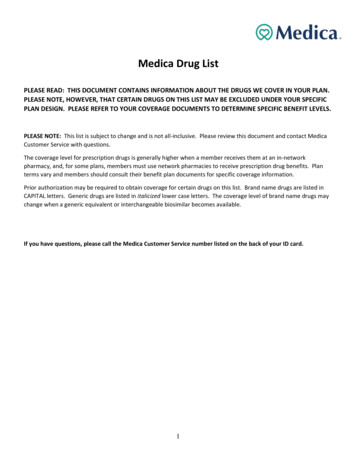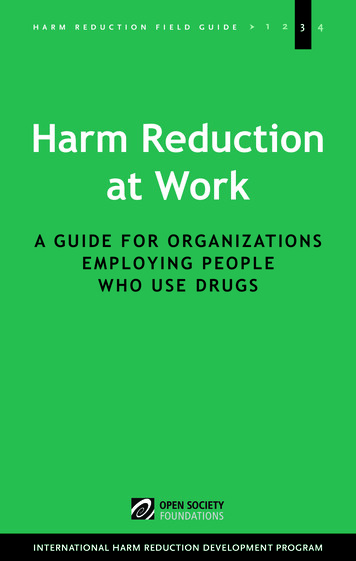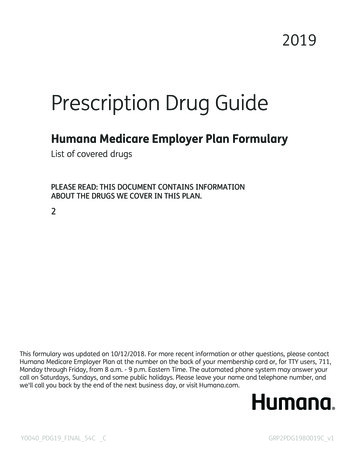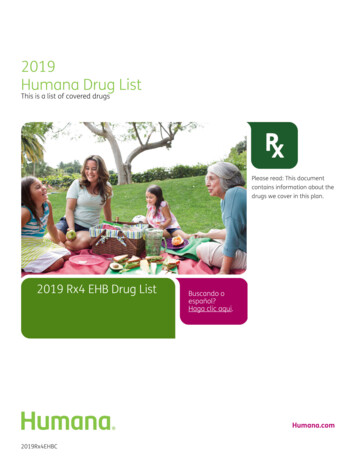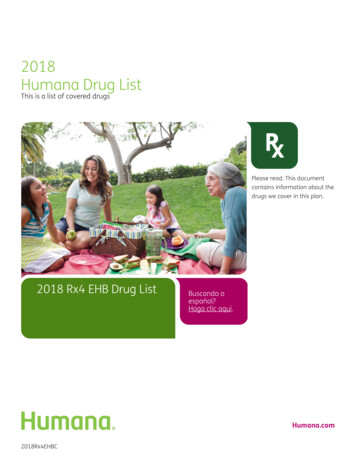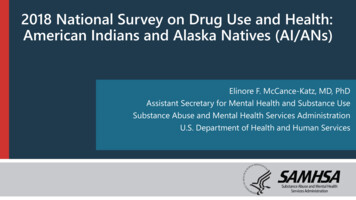
Transcription
2018 National Survey on Drug Use and Health:American Indians and Alaska Natives (AI/ANs)Elinore F. McCance-Katz, MD, PhDAssistant Secretary for Mental Health and Substance UseSubstance Abuse and Mental Health Services AdministrationU.S. Department of Health and Human Services1
National Survey on Drug Use and Health (NSDUH) NSDUH is a comprehensive household interview survey of substance use,substance use disorders, mental health, and the receipt of treatment services forthese disorders in the United States. NSDUH is collected face-to-face by field interviewers who read less sensitivequestions to respondents and transition respondents to audio computer assistedself-interviewing for sensitive items. NSDUH covers the civilian, noninstitutionalized population, aged 12 or older: Includes: Households, college dorms, homeless in shelters, civilians onmilitary bases Excludes: Active military, long-term hospital residents, prison populations,homeless not in shelters Sample includes all 50 states and DC Approximately 67,500 persons are interviewed annually Data collected from January to December2
How Do We Use NSDUH? Provides a window into the state of substance use and mentalhealth issues in the United States Helps to guide policy directions: problem substances prevalence of mental illness intersection of substance use and mental health issues provides insights that can be studied in the context of datafrom other agencies to help in decision-making about whattypes of resources are needed and where resources should bedirected3
NSDUH 2017 Highlights4 Opioids epidemic: New users of heroin significantly decreased relative to 2016 Significant decreases in pain reliever misuse were observed for all ages Downward trend in heroin users Estimated 2.1M with opioid use disorder Marijuana: Significant increases in use by young adults (18-25 y.o.): past month anddaily/near daily use; with significant increases in use by young adult women Pregnant women using substances in greater numbers including significantincreases in daily or near daily marijuana use Frequent marijuana use was associated with opioid misuse, heavy alcohol use,and depression in youth 12-17 and young adults 18-25 Young adults had increasing rates of serious mental illness, major depression, andsuicidality Co-occurring substance use and mental disorders are common Major gaps in treatment received by affected individuals
SAMHSA’s Response to 2016-17 NSDUH Findings 2018: Launch of new approach to technical assistance and training Previous focus on technical assistance to grantees expanded to national approach Establishment of Clinical Support System for Serious Mental Illness National practitioner training efforts Focus on appropriate use and monitoring of psychotropic medications Use of clozapine in treatment refractory schizophrenia Assisted outpatient treatment Establishment of a regional system of Technology Transfer Centers throughout the U.S. Substance Abuse Prevention Technology Transfer Centers Addiction Technology Transfer Centers Mental Health Technology Transfer Centers with supplements for school-based services Training and technical assistance tailored to needs of HHS regions Native American/Alaska Native, Hispanic/Latino focus centers Establishment of new national training/technical assistance programs State Targeted Response/State Opioid Response TA/T Program-over 1000 requests met Privacy Technology Transfer Center addressing confidentiality and information sharingrelated to HIPAA and 42CFR Eating Disorders Technology Transfer Center5
SAMHSA’s Response to NSDUH Findings Established PCSS-Universities to embed DATA waiver training in pre-graduateeducation for physicians, nurse practitioners and physician assistants Expanded training and technical assistance on opioids issues in rural Americathrough supplements to USDA Cooperative Extension programs Re-established the Drug Abuse Warning Network (DAWN) Expanded the Suicide Prevention Lifeline network Public targeted messaging based on areas of concern identified in NSDUH:marijuana, methamphetamine, suicide prevention6
Mental Illness and Substance Use Disordersamong AI/AN Adults ( 18 y.o.)7
Alcohol Initiates among AI/ANsOverall USpopulation12-179.6%8
Alcohol Use among AI/ANsOverall USpopulation18-2555.1%Overall USpopulation12-179.0%9Overall USpopulation26 55.3%
Alcohol Use Disorder among AI/ANsOverall USpopulation26 5.1%10
Summary: Alcohol Use in 2018 No significant changes in initiation of alcohol use, alcohol use, and alcohol use disorderamong AI/ANs across all age groups during 2015-2018 SAMHSA efforts on reductions in alcohol use in children/youth/transition age youth: CSAP DFC program prioritizes alcohol use and has reported a 27% reduction in use inmiddle-school and a 23% reduction in use by high school students SAMHSA Prevention Technology Transfer Centers produce resources and materials relatedto alcohol misuse prevention CSAP ‘Talk They Hear You’ focuses on underage drinking CSAP requires Partnerships for Success grantees to emphasize underage drinkingprevention CSAT has promoted SBIRT for alcohol use in all programs including CJ, PPW, adolescenttreatment, HIV and homeless programs CSAT has funded SBIRT training in medical residencies and other healthcare practitionerprograms which screen for hazardous alcohol use and use disorders11
Illicit Drug Use among AI/ANs: Marijuana Most Used DrugOverall USpopulation12 15.9%12
Prescription Pain Reliever Misuse among AI/ANs13
Opioid Misuse among AI/ANs14
Prescription Pain Reliever Misuse and Heroin Useamong AI/ANs15
Prescription Pain Reliever Misuse among AI/ANsOverall USpopulation18-255.5%Overall USpopulation12-172.8%16Overall USpopulation26 3.4%
Misuse of Prescription Opioid Subtypes among AI/ANsOverall USpopulation12 11.5%17
Heroin Use among AI/ANs18
Heroin Use among AI/ANs19
Heroin-Related Opioid Use Disorder among AI/ANs20
Treatment Gains: Number of Individuals ReceivingPharmacotherapy for Opioid Use Disorder Total Number receiving MAT(all 72,371120000020172018Note: Estimates do not represent AI/ANs and are not based on NSDUH.Naltrexone201620172018
Summary: Opioid Misuse and Use Disorderin the United States in 2018 Across all AIAN age groups, no significant changes in prescription opioid misuse,initiation of misuse, and use disorders during 2015-2018 No significant changes in heroin use initiation, use, and use disorder among AIANsduring 2015-201822
Other Illicit Substances23
Marijuana Use among AI/ANsOverall USpopulation18-2522.1%Overall USpopulation12-176.7%24Overall USpopulation26 8.6%
Marijuana Use among AI/AN Young Adults (18-25 y.o.)Overall USpopulation18-2522.1%25
Marijuana Use among AI/AN Young Adult Men and Women (18-25 y.o.)Overall USpopulation18-2522.1%26
Marijuana Use among AI/AN Adults 26 Overall USpopulation26 8.6%Overall USpopulation26 2.8%27
Marijuana Use Disorder among AI/ANsOverall USpopulation18-255.9%28
Marijuana Use among AI/AN Women by Pregnancy StatusOverallWomen 15-44Not Pregnant13.7%29
Daily or Almost Daily Marijuana Use among AI/AN Women byPregnancy StatusOverallWomen 15-44Not Pregnant3.6%30
Substance Use in Pregnancy: Trends in the Right DirectionOverall U.S. women in 2017: Showed a startling increase in substance use andparticularly marijuana use in pregnancy: may be associated with fetal growthrestriction, stillbirth, and preterm birth; may cause problems with neurologicaldevelopment, resulting in hyperactivity, poor cognitive function (Metz TD and Stickrath EH,2015) SAMHSA/HHS made strong efforts to address this situation in an effort to improve the health andmothers and their babies: Public awareness efforts: information sharing with stakeholders and the public Launch of SAMHSA.gov/marijuana Launch of Substance Abuse Prevention Technology Transfer Centers with a focus on marijuana andother substance use in pregnancy Expansion of treatment programs for pregnant/post partum parenting women: both residential andoutpatient through CARA Publication of Clinical Guidance for Treating Pregnant and Parenting Women with Opioid Use Disorder Publication of Healthy Pregnancy/Healthy Baby Factsheets for women and their families Use of STR and SOR funding for opioid use disorder in pregnancy and prevention interventions Joint article from Assistant Secretary for Mental Health and Substance Use and Surgeon Generaladdressing treatment of opioid use disorder in pregnancy31
Cocaine Use among AI/ANs: Significant Decline among YoungAdults (18-25 y.o.)32
Methamphetamine Use among AI/ANsOverall USpopulation18-250.8%33Overall USpopulation26 0.7%
Methamphetamine Use among AI/ANs by State34
Misuse of Prescription Stimulants among AI/ANsOverall USpopulation18-256.5%35
AI/AN Hallucinogen Use: LSD36
Summary: Other Substance Use in the United States in 2018 No significant changes in marijuana use and use disorder among AI/ANs across all agegroups Significant decline in cocaine use in AI/AN aged 18-25 from 2017 to 2018 Significant increase in methamphetamine use in AI/ANs aged 26 during 2016-2018 No significant changes in prescription stimulant misuse and LSD use among AI/ANsacross all age groupsPREVENTION WORKS!37
Mental Health38
Serious Mental Illness (SMI) among AI/ANs39
Major Depressive Episodes among AI/ANsOverall USpopulation18-2513.8%40
Major Depressive Episodes with Severe Impairment among AI/ANAdolescents41
Major Depressive Episodes with Severe Impairment among AI/ANYoung Adults (18-25 y.o.)Overall USpopulationMale 18-256.5%42
Suicidal Thoughts, Plans, and Attempts among AI/AN YoungAdults (18-25 y.o.)Overall USpopulation18-2511.0%Overall USpopulation18-253.4%43Overall USpopulation18-251.9%
Co-Occurring Disorders44
Co-Occurring Issues: Substance Use among AI/AN Adults, byMental IllnessOverall USpopulation18 16.3%45Overall USpopulation18 9.6%Overall USpopulation18 25.3%
Co-Occurring Issues: Substance Use among AI/AN Adults, byMental IllnessOverall USpopulation18 15.7%Overall USpopulation18 13.2%Overall USpopulation18 2.5%46
Alcohol Use Related to Other Substance Use, MDE and SMIamong AI/ANs47
Marijuana Use Related to Other Substance Use, MDE and SMIamong AI/ANs48
Opioid Misuse Related to Other Substance Use, MDE and SMIamong AI/ANs49
Cocaine Use Related to Other Substance Use, MDE and SMIamong AI/ANs50
Methamphetamine Use Related to Other Substance Use, MDEand SMI among AI/ANs51
Co-Occurring Substance Use Disorder (SUD) and SuicidalThoughts, Plans, and Attempts among AI/AN AdultsOverall USpopulation18 2.8%52
Summary: Mental Health Issues in the United States in 2018 No significant change in serious mental illness in AI/ANs aged 18 during 2008-2018 Significant increase in major depressive episode in AI/ANs aged 18-25 between 2015and 2018 Significant increase in major depressive episode with severe impairment among AI/ANwomen aged 18-25 during 2016-201853
2018: A Year of Some Progress, but Ongoing Need for AmericansLiving with Substance Use and Mental Health Issues ContinuesNSDUH reveals areas where we need to focus resources: 54Continuing need to address the ongoing opioid epidemicSignificant increase in methamphetamine in AI/AN adults aged 26 Significant decrease in cocaine use in AI/AN aged 18-25Significant increase in major depressive episode in AI/ANs aged 18-25
SAMHSA’s Response Workforce: Continue to address the need for clinicians to be prepared to assess and treat mentalhealth issues and substance issues with national training and technical assistance programs Opioids Continue work with states to address opioids crisis needs in terms of prevention, treatment, andcommunity recovery resources STR/SOR/TOR grants Discretionary grants: pregnant/post partum parenting women/children/families, drug courts, firstresponder/prevention grants Collaboration with HHS partners and other federal departments to expand resources tocommunities Other substances: Encourage use of block grant funds to address prevention/treatment needs Provide training and technical assistance on evidence-based psychosocial therapies Connecting with the public: Importance of Prevention, Treatment, Community Supports Public service messaging on substance use and mental health issues with focus on prevention -ttc Monitoring outcomes: Through continuation of NSDUH, DAWN, and SAMHSA grant program evaluation Making policy modifications as indicated55
National Survey on Drug Use and Health (NSDUH) NSDUH is a comprehensive household interview survey of substance use, substance use disorders, mental health, and the receipt of treatment services for these disorders in the United States. NSDUH is collected face-to-face by field interviewers who read less sensitive


